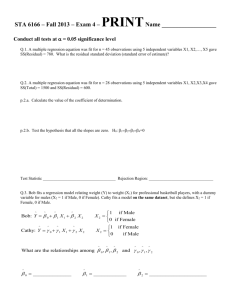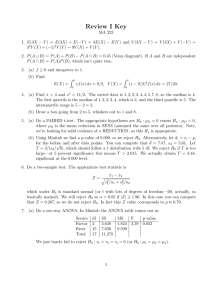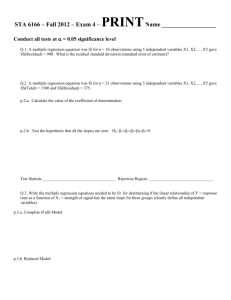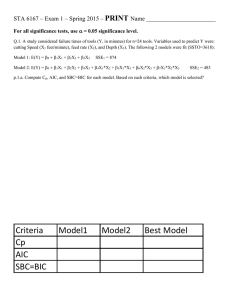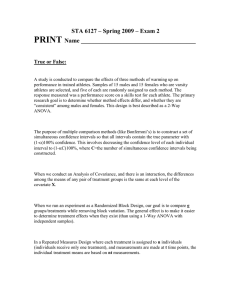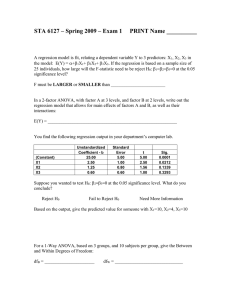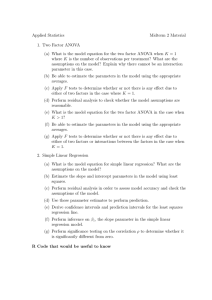PRINT STA 6167 – Exam 1 – Fall 2014 – Name _______________________
advertisement
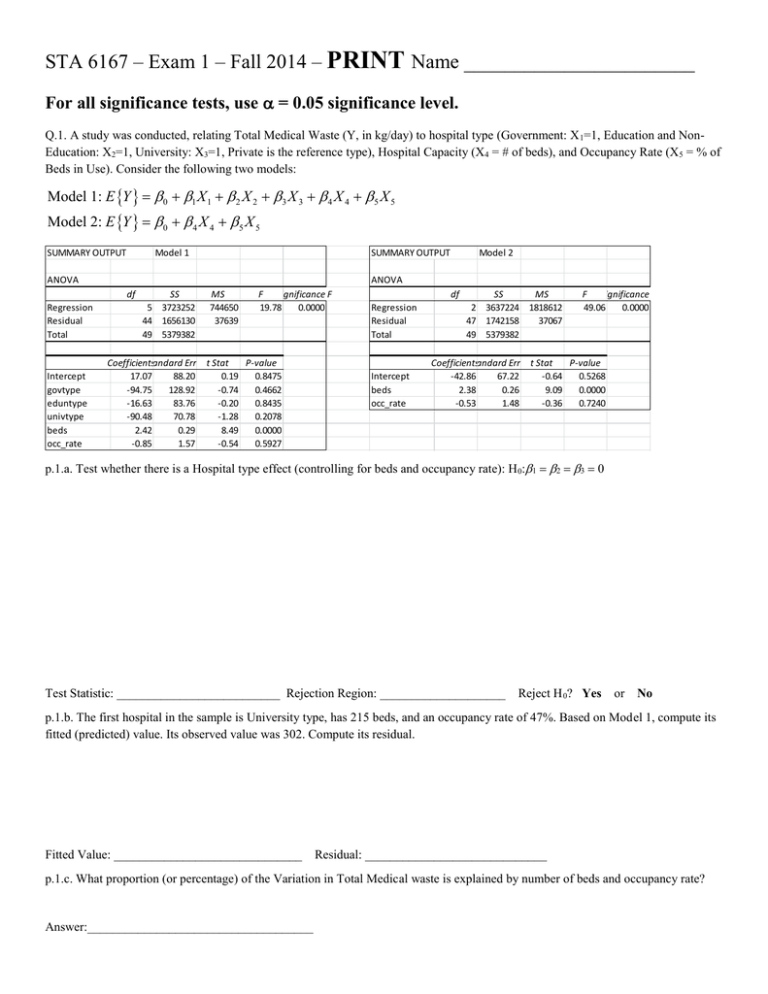
STA 6167 – Exam 1 – Fall 2014 – PRINT Name _______________________ For all significance tests, use = 0.05 significance level. Q.1. A study was conducted, relating Total Medical Waste (Y, in kg/day) to hospital type (Government: X 1=1, Education and NonEducation: X2=1, University: X3=1, Private is the reference type), Hospital Capacity (X4 = # of beds), and Occupancy Rate (X5 = % of Beds in Use). Consider the following two models: Model 1: E Y 0 1 X 1 2 X 2 3 X 3 4 X 4 5 X 5 Model 2: E Y 0 4 X 4 5 X 5 SUMMARY OUTPUT Model 1 SUMMARY OUTPUT ANOVA ANOVA df Regression Residual Total Intercept govtype eduntype univtype beds occ_rate Model 2 SS 5 3723252 44 1656130 49 5379382 MS 744650 37639 F Significance F 19.78 0.0000 Coefficients Standard Error t Stat P-value 17.07 88.20 0.19 0.8475 -94.75 128.92 -0.74 0.4662 -16.63 83.76 -0.20 0.8435 -90.48 70.78 -1.28 0.2078 2.42 0.29 8.49 0.0000 -0.85 1.57 -0.54 0.5927 df Regression Residual Total Intercept beds occ_rate SS MS 2 3637224 1818612 47 1742158 37067 49 5379382 F Significance F 49.06 0.0000 Coefficients Standard Error t Stat P-value -42.86 67.22 -0.64 0.5268 2.38 0.26 9.09 0.0000 -0.53 1.48 -0.36 0.7240 p.1.a. Test whether there is a Hospital type effect (controlling for beds and occupancy rate): H 0: Test Statistic: __________________________ Rejection Region: ____________________ Reject H 0? Yes or No p.1.b. The first hospital in the sample is University type, has 215 beds, and an occupancy rate of 47%. Based on Model 1, compute its fitted (predicted) value. Its observed value was 302. Compute its residual. Fitted Value: ______________________________ Residual: _____________________________ p.1.c. What proportion (or percentage) of the Variation in Total Medical waste is explained by number of beds and occupancy rate? Answer:____________________________________ Q.2. A study related Personal Best Shot Put distance (Y, in meters) to best preseason power clean lift (X, in kilograms). The following models were fit, based on a sample of n = 24 male collegiate shot putters: ^ Model 1: E Y 0 1 X SSE1 43.41 R12 .686 Y X 4.4353 0.0898 X Model 2: E Y 0 1 X 2 X 2 SSE2 37.41 R22 .729 Y X , X 2 12.08 0.3285 X 0.00084 X 2 ^ p.2.a. Use Model 2 to test H0: (Y is not related to X) Test Statistic: __________________________ Rejection Region: ____________________ Reject H0? Yes or No Reject H 0? Yes or No p.2.b. Use Models 1 and 2 to test H0: (Y is linearly related to X) Test Statistic: __________________________ Rejection Region: ____________________ p.2.c. Obtain the predicted value from each model for a man with best power clean of 175 kg. Model 1: _____________________________________________ Model 2: __________________________________________ Q.3. A regression model is fit relating weight (Y, in lbs) to height (X, in inches) among n=139 WNBA players (treating this as a random sample of all female athletes from sports such as basketball and volleyball). The results from the regression, and the residual versus fitted plot are given below. ANOVA df Regression Residual Total SS 1 45933.13 137 35074.41 138 81007.54 Coefficients Standard Error Intercept -212.05 28.78 Height 5.32 0.40 p.3.a. Test H0: 1 = 0 (Weight is not associated with Height) based on the t-test. Test Statistic: __________________________ Rejection Region: ____________________ Reject H 0? Yes or No Reject H 0? Yes or No p.3.b. Test H0: 1 = 0 (Weight is not associated with Height) based on the F-test. Test Statistic: __________________________ Rejection Region: ____________________ p.3.c. The residual plot appears to display non-constant error variance. A regression of the squared residuals on height (X) is fit, and the ANOVA is given below. Conduct the Breusch-Pagan test to test whether the errors are related to X. Do you reject the null hypothesis of constant variance? Yes or No ANOVA df Regression Residual Total SS 1 1070500 137 44788405 138 45858905 Test Statistic: __________________________ Rejection Region: ____________________ Reject H 0? Yes or No Q.4. An experiment was conducted as a Completely Randomized Design (1-Way ANOVA) to compare t = 4 methods of packaging steaks, in terms of the amount of bacteria measured after 9 days of storage. There were ni = 3 replicates per treatment. The treatment means and sums of squares were: Y 1 7.48 Y 2 5.50 Y 3 7.26 Y 4 3.36 4 ni Y i Y i 1 2 32.87 4 n 1 s i 1 i 2 i 0.93 p.4.a. Conduct the F-test for testing H0: Test Statistic: __________________________ Rejection Region: ____________________ Reject H 0? Yes or No p.4.b. Compute Tukey’s Honest Significant Difference for simultaneously comparing all pairs of packages, with a family-wise error rate of 0.05. Identify significant differences among all pairs of means. Trt4 Trt2 Trt3 Trt1 p.4.c. Compute Bonferroni’s Minimum Significant Difference for simultaneously comparing all pairs of packages, with a family-wise error rate of 0.05 Trt4 Trt2 Trt3 Trt1 Q.5 A data set consisted of n = 32 observations on the variables Y, X1, X2, X3, and X4. Error Sum of Squares = SSE for each of all possible models. For each model, the variables that are in the model are also shown. Use this information to answer the questions following the table. The Total Sum of Squares = SSTO = 1150. #Variables SSE 1 1 1 1 2 2 2 2 2 2 3 3 3 3 4 Cp 330 448 505 785 255 284 290 295 402 445 245 253 255 290 243 AIC SBC=BIC #N/A #N/A #N/A #N/A #N/A #N/A #N/A #N/A #N/A #N/A #N/A #N/A #N/A #N/A #N/A #N/A #N/A #N/A #N/A #N/A #N/A #N/A #N/A #N/A #N/A #N/A #N/A #N/A #N/A #N/A #N/A #N/A #N/A Vars in Model X2 X3 X1 X4 X2,X4 X2,X3 X1,X3 X1,X2 X1,X4 X3,X4 X1,X2,X4 X1,X2,X3 X2,X3,X4 X1,X3,X4 X1,X2,X3,X4 p.5.a. Complete the table by computing Cp, AIC, and SBC=BIC for the best models with 1,2,3, and 4 independent variables. p.5.b. Give the best model (in terms of which independent variables to be included), based on each criteria. Cp: ________________________ AIC: _____________________________ SBC=BIC: _________________________ Q.6. A linear regression model was fit, relating the electric potential (Y) to the current density (X) for a series of n=18 consecutively observed pairs of X and Y. Model: Yt 0 1 X t t t ~ N 0, 2 t t 1 t p.6.a. The estimated regression coefficients and standard errors for ordinary least squares are given below. Obtain a 95% Confidence Interval for the slope coefficient for current density (1). Coefficients: Estimate Std. Error t value Pr(>|t|) (Intercept) 891.460256 4.290707 207.76 <2e-16 *** x -0.431633 0.009523 -45.33 <2e-16 *** Lower Bound: _________________________________ Upper Bound: _____________________________________ p.6.b. The Durbin-Watson test is used to test H0: = 0. The test statistic and P-value are given below. Do you conclude that the errors are serially correlated (not independent)? Yes or No lag Autocorrelation D-W Statistic p-value 1 0.4923645 0.668015 0 p.6.c. The estimated regression coefficients and standard errors for estimated generalized least squares are given below. Obtain a 95% Confidence Interval for the slope coefficient for current density (1). Coefficients: Value Std.Error t-value p-value (Intercept) 895.8873 9.161308 97.79033 0 x -0.4488 0.018576 -24.16305 0 Lower Bound: _________________________________ Upper Bound: _____________________________________
